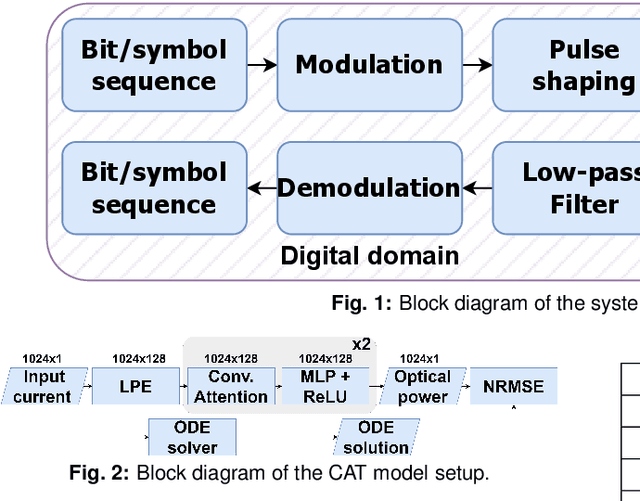Ognjen Jovanovic
Low-Complexity Event Detection and Identification in Coherent Correlation OTDR Measurements
Jan 29, 2025


Abstract:Pairing coherent correlation OTDR with low-complexity analysis methods, we investigate the detection of fast temperature changes and vibrations in optical fibers. A localization accuracy of ~2 m and extraction of vibration amplitudes and frequencies is demonstrated.
Coexistence Options and Performance Analysis of 100 Gbit/s Coherent PON in Brownfield DWDM Networks
Dec 20, 2024Abstract:We study system architectures for the coexistence of future coherent PON and DWDM networks. Considering deployed optical filters, we observe filtering penalties < 1dB at a laser frequency accuracy < 12GHz when using a cost-effective architecture.
Optimization of Pilot-Aided Joint Phase Recovery for Frequency Comb-Based Wideband Transmission
Dec 20, 2024Abstract:We numerically investigate joint pilot-aided phase recovery for frequency comb-based long-haul wideband transmission. We report net information rate gains by optimizing the pilot overhead and phase estimation algorithm, outperforming per-channel processing at lower complexity.
Differentiable Machine Learning-Based Modeling for Directly-Modulated Lasers
Sep 27, 2023Abstract:End-to-end learning has become a popular method for joint transmitter and receiver optimization in optical communication systems. Such approach may require a differentiable channel model, thus hindering the optimization of links based on directly modulated lasers (DMLs). This is due to the DML behavior in the large-signal regime, for which no analytical solution is available. In this paper, this problem is addressed by developing and comparing differentiable machine learning-based surrogate models. The models are quantitatively assessed in terms of root mean square error and training/testing time. Once the models are trained, the surrogates are then tested in a numerical equalization setup, resembling a practical end-to-end scenario. Based on the numerical investigation conducted, the convolutional attention transformer is shown to outperform the other models considered.
Low-complexity Samples versus Symbols-based Neural Network Receiver for Channel Equalization
Aug 28, 2023Abstract:Low-complexity neural networks (NNs) have successfully been applied for digital signal processing (DSP) in short-reach intensity-modulated directly detected optical links, where chromatic dispersion-induced impairments significantly limit the transmission distance. The NN-based equalizers are usually optimized independently from other DSP components, such as matched filtering. This approach may result in lower equalization performance. Alternatively, optimizing a NN equalizer to perform functionalities of multiple DSP blocks may increase transmission reach while keeping the complexity low. In this work, we propose a low-complexity NN that performs samples-to-symbol equalization, meaning that the NN-based equalizer includes match filtering and downsampling. We compare it to a samples-to-sample equalization approach followed by match filtering and downsampling in terms of performance and computational complexity. Both approaches are evaluated using three different types of NNs combined with optical preprocessing. We numerically and experimentally show that the proposed samples-to-symbol equalization approach applied for 32 GBd on-off keying (OOK) signals outperforms the samples-domain alternative keeping the computational complexity low. Additionally, the different types of NN-based equalizers are compared in terms of performance with respect to computational complexity.
Addressing Data Scarcity in Optical Matrix Multiplier Modeling Using Transfer Learning
Aug 10, 2023Abstract:We present and experimentally evaluate using transfer learning to address experimental data scarcity when training neural network (NN) models for Mach-Zehnder interferometer mesh-based optical matrix multipliers. Our approach involves pre-training the model using synthetic data generated from a less accurate analytical model and fine-tuning with experimental data. Our investigation demonstrates that this method yields significant reductions in modeling errors compared to using an analytical model, or a standalone NN model when training data is limited. Utilizing regularization techniques and ensemble averaging, we achieve < 1 dB root-mean-square error on the matrix weights implemented by a photonic chip while using only 25% of the available data.
Rate Adaptive Geometric Constellation Shaping Using Autoencoders and Many-To-One Mapping
Jul 19, 2023Abstract:A many-to-one mapping geometric constellation shaping scheme is proposed with a fixed modulation format, fixed FEC engine and rate adaptation with an arbitrarily small step. An autoencoder is used to optimize the labelings and constellation points' positions.
Data-Driven Modeling of Directly-Modulated Lasers
May 15, 2023



Abstract:The end-to-end optimization of links based on directly-modulated lasers may require an analytically differentiable channel. We overcome this problem by developing and comparing differentiable laser models based on machine learning techniques.
Data-efficient Modeling of Optical Matrix Multipliers Using Transfer Learning
Nov 29, 2022

Abstract:We demonstrate transfer learning-assisted neural network models for optical matrix multipliers with scarce measurement data. Our approach uses <10\% of experimental data needed for best performance and outperforms analytical models for a Mach-Zehnder interferometer mesh.
Reservoir Computing-based Multi-Symbol Equalization for PAM 4 Short-reach Transmission
Nov 29, 2022Abstract:We propose spectrum-sliced reservoir computer-based (RC) multi-symbol equalization for 32-GBd PAM4 transmission. RC with 17 symbols at the output achieves an order of magnitude reduction in multiplications/symbol versus single output case while maintaining simple training.
 Add to Chrome
Add to Chrome Add to Firefox
Add to Firefox Add to Edge
Add to Edge